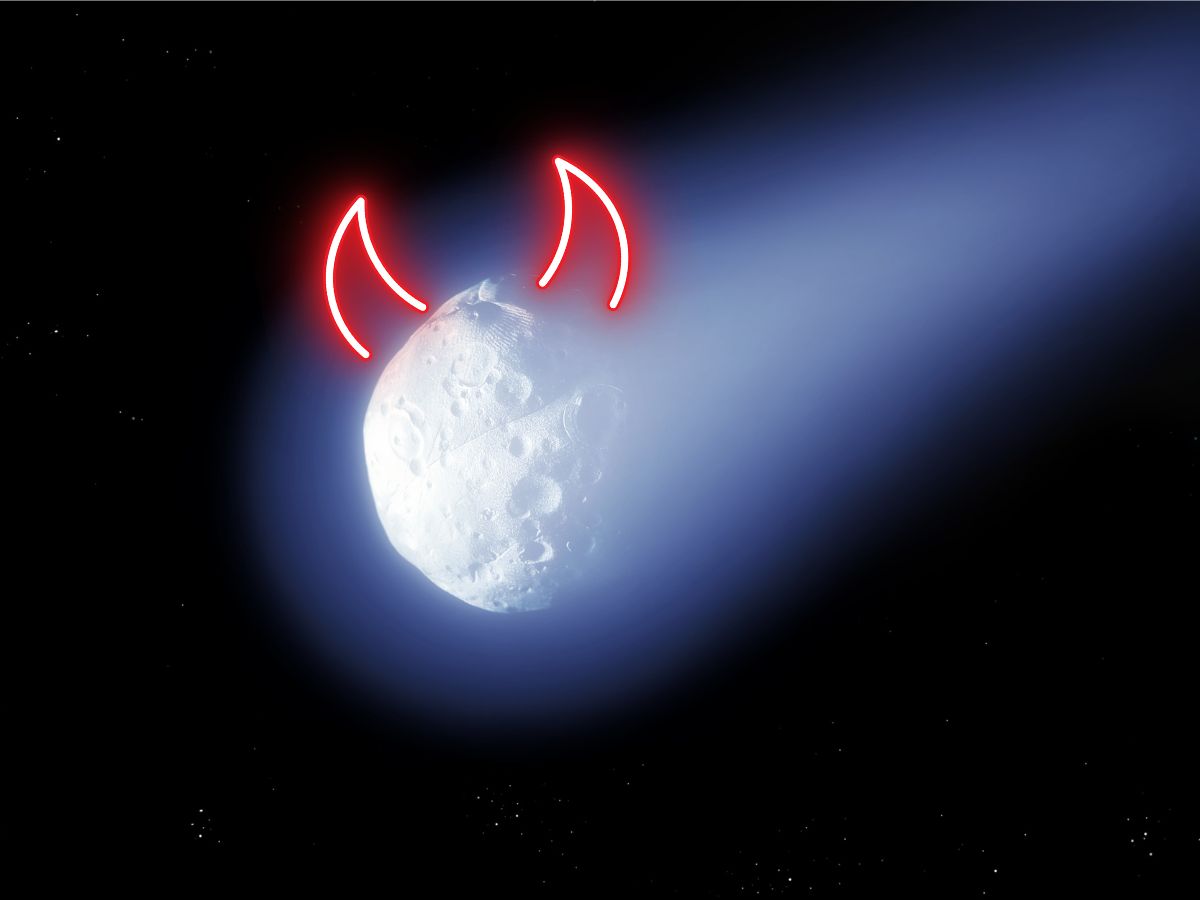
With a name like the “Devil Comet,” it’s easy to understand why its rare, “once-in-a-lifetime” appearance might cause alarm. Although, “once-in-a-lifetime” is a little misleading. It depends on when you’re born. There are those who were alive the last time it made an appearance in 1954. Just like today’s youth will have another chance to see it when it reappears in 2095 if they live long enough. So it is possible for some to experience it twice in a lifetime.
The last time Comet 12P/Pons-Brooks, a.k.a. the “Devil Comet,” passed by Earth like it will this year was September 4, 1954. Interestingly enough, there was a total solar eclipse that year, too, like there will be on April 8, 2024. (The solar eclipse in 1954 happened on June 30, though.)
Also interesting, the sun will play a major part in why the comet will be visible to us here on Earth. We’ll get to that, as well as why its name is misleading. But first, let’s explore why it’s called the Devil Comet, where to look to see it, and if there’s any chance it could spark a Night of the Comet scenario.
Why They Call It the Devil Comet
Comet 12P/Pons-Brooks, discovered in 1912 by Jean Louis-Pons, wasn’t always nicknamed the Devil Comet. Astronomy.com explained it’s a relatively new media-generated moniker, thanks to something that happened with the comet in 2023.
In July 2023, it experienced an “outburst” that distorted its coma-shaped tail into “a horseshoe or horned shape, with a dark center and bright wings or points.”
Although, the Devil Comet wasn’t the only nickname some gave it. The Millennium Falcon Comet also came up. However, that’s not as exciting or provocative a name, so when it had another outburst in February 2024 that made the horns visible again, the Devil Comet stuck.
Seeing the Devil Comet
Space.com explained best why the sun matters for seeing the Devil Comet. It has to do with what it’s made of and a process called sublimation.
It’s a “cryovolcanic comet,” which means beneath its icy outer shell lies “a heart of ice, gas and dust.” Sublimation, when radiation from the Sun heats up the comet, transforms it into gas. Apparently, the process “is more explosive and dramatic for the Devil Comet than most other icy bodies.”
The cryovolcanic nature of 12P/Pons-Brooks allows the interior of the comet to be superheated, letting pressure build-up until it explosively cracks the comet’s outer shell and sprays matter into space.
These “powerful outbursts” create “a halo-like coma” to sprout from the Devil Comet. It’s the perfect platform for reflecting sunlight, and the closer it gets to the sun, the brighter its coma glows.
With the right equipment, such as a telescope or even a pair of binoculars, Comet 12P/Pons-Brooks is visible now. But pretty soon, especially on April 21, when it’s closest to the sun, the Devil Comet will be visible with the naked eye—as long as Mother Nature cooperates with clear skies, that is.
March 30 and 31 will also be particularly good times to see it, especially against the backdrop of Pegasus and Aries. During April, it will “disappear into the sunset glow” until it reaches perihelion on April 21. After that, people in the Southern Hemisphere will get a chance to see it until June, when it disappears from Earth’s view for another 71 years.
Night of the Comet IRL?
Astronomy.com assures worrywarts that, despite its hellish name, “the Devil Comet is no danger to Earth.” 12P/Pons-Brooks will be inside Earth’s orbit when it reaches perihelion, but it will still be far enough away not to cause us any trouble.
Phew.
Check-In
Have you seen the Devil Comet yet? If not, do you plan to try and spot it before it moves on?
Courtney Mroch is a globe-trotting restless spirit who’s both possessed by wanderlust and the spirit of adventure, and obsessed with true crime, horror, the paranormal, and weird days. Perhaps it has something to do with her genes? She is related to occult royalty, after all. Marie Laveau, the famous Voodoo practitioner of New Orleans, is one of her ancestors. (Yes, really! As explained here.) That could also explain her infatuation with skeletons.
Speaking of mystical, to learn how Courtney channeled her battle with cancer to conjure up this site, check out HJ’s Origin Story.

I have seen 12P/Pons-Brooks. Yeah, thank goodness it doesn’t pose a threat to Earth. I sent you a picture of it to your admin email.
Priscilla!!! I saw your email before I saw your comment. (Took the weekend off from all things computer while we spent time with some out of town friends.) But the first thing I discovered was your email with that awesome photo!!!! OMG! What a way to start a Monday!!! I was THRILLED!!!!!!!!!!!! Thank you, thank you, THANK YOU again for sharing that!!!!!